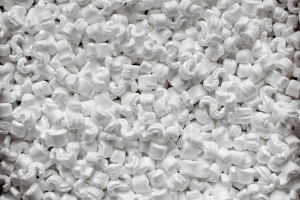Polystyrene (PS): this word, if it sounds familiar to someone not associated with the chemical industry, most often brings to mind various types of packaging. However, there are many more applications of polystyrene. Let's take a closer look at this extremely interesting and useful material, which has a Polish accent in its long history!

Polystyrene – what is it?
First of all, it is necessary to explain what polystyrene (PS for short) is and how it is produced. It is a synthetic plastic (polymer) obtained by polymerisation of styrene. It is a process as a result of which styrene molecules are combined into long chains to form a solid material. Thanks to its characteristic structure, polystyrene is stiff, lightweight and transparent.
One of the forms of polystyrene is granulate. Its foaming produces polystyrene foam, a popular insulating material in the construction industry. To obtain light, low-density polystyrene foam, polystyrene granules are double-foamed. Then, the material is dried and formed into appropriately sized blocks.
Read also: insulating your home with polystyrene foam
As an interesting fact, it can be added that the history of polystyrene is closely associated with Poland, more precisely with the outstanding Polish chemist Kazimierz Smoleński. We owe him the development of effective methods of producing both styrene and polystyrene. He achieved this already in the interwar period!
Applications of polystyrene
Everyone will probably agree that the use of plastic in everyday life is evident at every turn. Even if we are not aware of the specific material in question, we see the materials everywhere around us.
Polystyrene is an extremely versatile material, which makes it applicable in various fields and industries. Here are the most popular applications:
- packaging – due to its lightness and durability, PS is ideal for the packaging of food products, electronics and cosmetics,
- construction – as thermal and acoustic insulation in the form of polystyrene foam,
- manufacture of household products – e.g. housings for household appliances,
- decorative and advertising elements – due to ease of processing.
The most important properties of polystyrene
In another post, we discussed in detail the properties and applications of polymers as a whole wide group of chemical substances. Now, it’s time to focus on the specific properties of polystyrene, which translate into the wide range of applications of that material. The most important include:
- lightness,
- resistance to moisture,
- good thermal and acoustic insulation,
- ease of processing and forming.
It is also worth paying attention to high stiffness and dimensional stability.

Polystyrene (PS) – advantages
The properties of polystyrene and its applications partly explain why it is so popular. In addition to the already-mentioned lightness and versatility, the material also has other advantages, such as:
- safe for health: PS is safe in contact with food, which allows it to be used in the production of food packaging,
- affordable: polystyrene is relatively cheap to produce, which makes it easily available and economically viable for many applications,
- resistance to solvents: PS shows good resistance to many solvents, which is important, e.g., in the case of wall stucco.
Given the increasing focus on ecology, both from producers, regulators and consumers, the question arises: which plastics are recyclable? We have already dealt with that issue in broad terms.
In the context of that material, the most important issue is whether the specific PS material can be recycled. The answer is yes, it is possible to process and reuse, e.g., disposable food packaging made of polystyrene.
Read also: what is recycling?
As you can see, polystyrene is a material that has a significant impact on our everyday life and industry and also boasts numerous advantages.
- https://www.britannica.com/science/polystyrene
- https://www.plastech.pl/plastechopedia/Polistyren-26
- Wypych, George (2012). "PS polystyrene". Handbook of Polymers. pp. 541–7
- Yousif, E., & Haddad, R. (2013). "Photodegradation and photostabilization of polymers, especially polystyrene: review". SpringerPlus, 2(1), 398. DOI: 10.1186/2193-1801-2-398